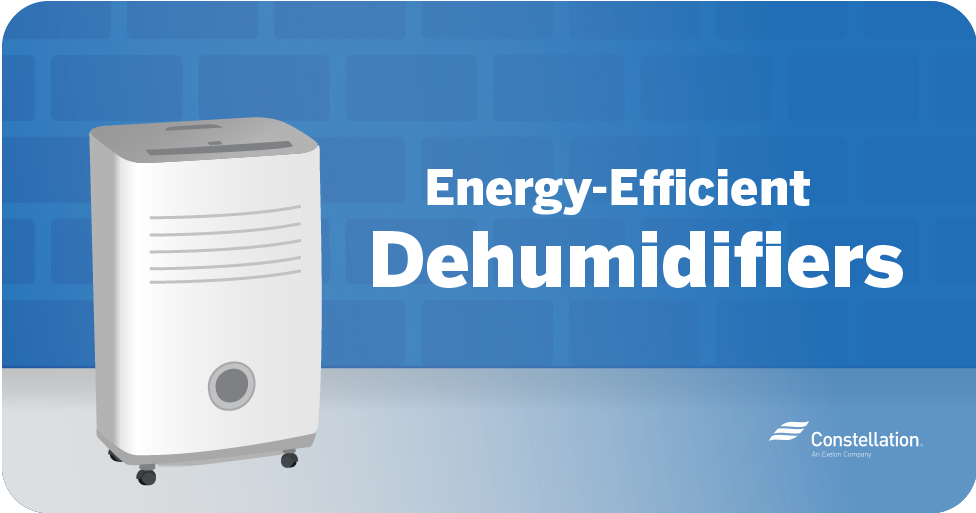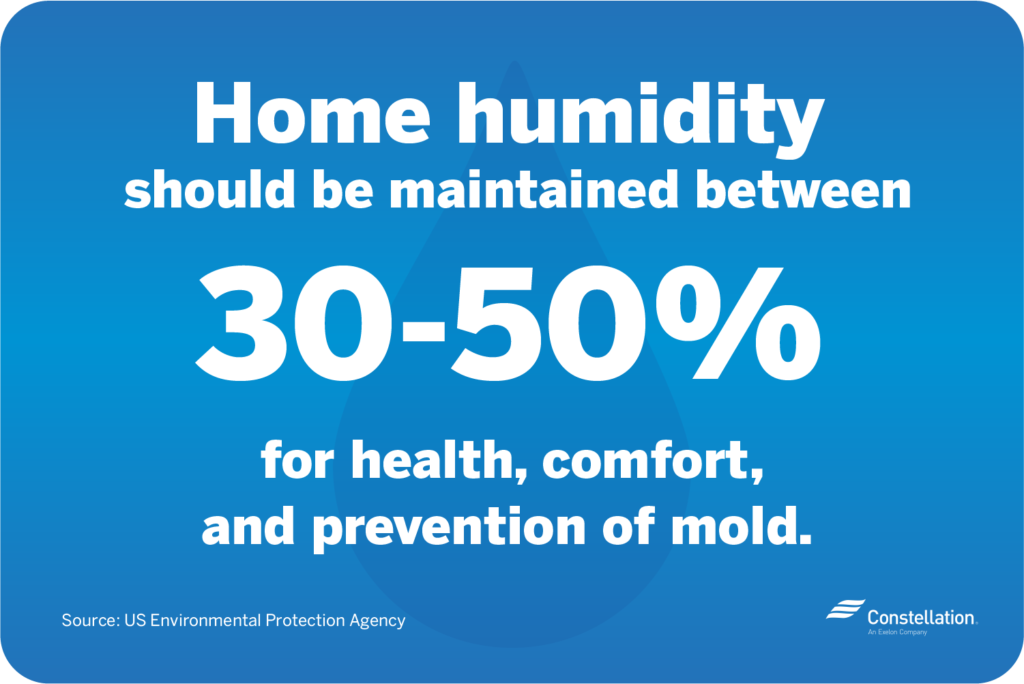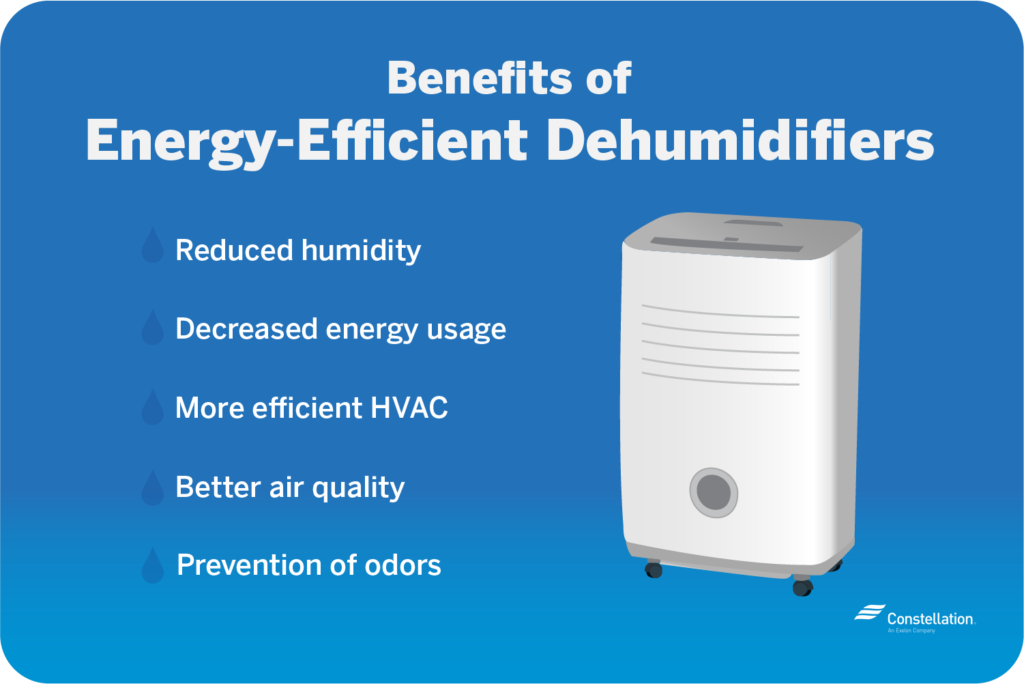
- Category:
Energy Efficiency -
Last updated:
April 16, 2025
Energy-Efficient Dehumidifiers: How to Choose the Best Dehumidifier for Your Home
Properly maintaining your home’s humidity can be important for both your health and your living space. Too much humidity in your house could possibly result in mold and wood rot, and aggravate allergy and asthma symptoms. Dehumidifiers can help combat these problems by managing humidity, but older models can likely won’t have the same energy-efficient features as newer models, and may also be more prone to leaks and mold accumulation.
If your home struggles with high humidity, a professional can help you identify potential problems and their causes. One solution may be to then invest in an energy-efficient dehumidifier to help you control your home’s humidity levels to help keep your energy bill manageable.
What is the ideal home humidity?
When people talk about a home’s humidity, they’re often referring to relative humidity (RH), which is the amount of water vapor in the air as compared to the maximum amount of water vapor the air can hold at the same temperature. According to the U.S. Environmental Protection Agency, your home’s humidity (RH) should be kept between 30% and 50% for health, comfort, and the prevention of mold and bacterial growth.

This level of humidity should be maintained during the summer and winter, with or without the use of an air conditioner. In cold climates, keeping your house’s humidity between 30% and 40% can help prevent condensation on windows. A dehumidifier with a built-in humidistat allows you to set the humidity for a given room or area within your home.
How do I know if I need a dehumidifier?
Unsure when to use a dehumidifier in your home? A hygrometer is a gauge used to measure humidity levels, and it can help you determine whether you have too much humidity in your house. There are also several observable signs that may indicate a humidity problem:
- Must or mildew odors. A strong smell of must or mildew may indicate high humidity and the possible presence of wood rot or mold.
- Wall and window condensation. Moisture condensing on walls or windows, especially in winter, may suggest too much humidity in the house.
- Water stains on walls or ceilings. While water stains may indicate attic or plumbing leaks, they can also be a sign of excess humidity.
- Increases in allergy and asthma symptoms. Dust mites and mold — two common allergens — thrive in high humidity, and people with asthma often find breathing more difficult in humid environments.
- Mold spots. High humidity encourages the growth of dark mold spots on walls and ceilings, especially in bathrooms, kitchens and other rooms where water is often used.
What are the benefits of a dehumidifier?

The benefits of using a dehumidifier may outweigh the costs — as long as the dehumidifier conserves energy. With an energy-efficient dehumidifier, you could possibly see several benefits:
- Reduced humidity. This is, of course, the primary goal. A dehumidifier draws moisture out of the air for a more comfortable home environment.
- Decreased energy usage. Energy-efficient dehumidifiers save enough energy annually to power an ENERGY STAR®️–certified refrigerator for two months.
- A more efficient HVAC. Your HVAC system works harder to cool moist air, and damp dust in the system’s ducts also increases workload. Dehumidifiers allow your air conditioning and heating system to operate more effectively, in turn reducing energy consumption.
- Better air quality. Ideal home humidity levels may reduce airborne dust and mold particles, helping to alleviate allergy and asthma symptoms.
- Prevention of odors. Dehumidifiers reduce unwanted smells by controlling dust, mold and mildew.
How to choose an energy-efficient dehumidifier
Choosing the right dehumidifier for your home requires an understanding of the different types of dehumidifiers, dehumidifier energy consumption, ENERGY STAR®️ certifications, dehumidifier sizing and house humidity levels.
When deciding on the best energy-efficient dehumidifier, you should pick a dehumidifier type based upon your home humidity levels, where it will be located in your home and the climate of where you live.
Types of energy-efficient dehumidifiers
There are several types of dehumidifiers to choose from:
Energy-efficient compressor dehumidifier
Compressor dehumidifiers work by passing warm, damp air over a refrigerated coil, causing condensation, which is then channeled into a tank for removal. The dry air is heated to room temperature and then released.
Compressor dehumidifiers work best in warmer climates, as the condenser must be cooler than room temperature. They’re less suited to cold climates and can be bulky and noisy, so it’s important to consider their placement in your home.
Desiccant dehumidifier vs. compressor dehumidifier
If you need to control basement humidity, a desiccant dehumidifier is a good choice. Desiccant dehumidifiers use a desiccant wheel to remove moisture, rather like the way silica gel keeps food items moisture-free. A built-in heater restores the wheel’s ability to absorb moisture.
Though they are portable dehumidifiers, desiccant dehumidifiers can be more expensive and may be less effective in warm climates.
Thermoelectric dehumidifiers vs. compressor dehumidifiers
Thermoelectric dehumidifiers use a solid-state thermoelectric device to pump heat from one side of the condenser to another, cooling the opposite side in the process. As air is drawn over the cold side, it causes condensation, which is then stored in a removable tank.
Since thermoelectric dehumidifiers aren’t designed to remove as much moisture as compressors or desiccants, they’re best suited for small spaces such as closets and bathrooms.
What to look for in an energy-efficient dehumidifier
To reap all the benefits of a dehumidifier, you’ll need to select the right model for your home. Dehumidifier features vary from model to model. While energy efficiency is important, homeowners should also look for features that allow you to control humidity levels and are easy to maintain.
Consider the following when looking for dehumidifiers:
- Is the dehumidifier certified by ENERGY STAR®️? Dehumidifier energy consumption is a key consideration. Check for the yellow EnergyGuide label, which will tell you if the product is ENERGY STAR®️–certified.
- Does the dehumidifier have a humidistat? Humidistats measure relative humidity and allow you to adjust the room’s humidity to fit your needs.
- What are the water drainage features of the dehumidifier? Most dehumidifiers store condensed water in a tank for removal. Look for a model in which the tank can be easily removed or one that uses gravity or a pump to drain automatically.
- Can you check the air discharge location? In other words, how does the dehumidifier return dried air to the room? A model that releases air from the top of the unit can be placed directly against a wall, whereas others may require more space for proper circulation.
- Does the model have a timer? A timer allows you to proactively control when the dehumidifier turns on and off, which could help save on dehumidifier energy consumption.
- Does the model restart automatically? An auto-restart option ensures the dehumidifier will turn back on again in the event of a power outage.
- Does the model have frost sensors? Running a dehumidifier in cold environments can allow frost to buildup on the condenser coils, thus limiting efficiency. A frost sensor directs the dehumidifier to shut off and defrost when this happens.
- Does the dehumidifier clean the air? Some dehumidifiers are built with antimicrobial filters that clean the air as they work.
- Are air filters easy to remove? Regularly cleaning your dehumidifier’s air filters is essential for optimal performance. Check to see if the air filters are easy to remove, clean and replace.
- What’s the dehumidifier’s operating temperature range? Selecting an energy-efficient dehumidifier that fits the temperature range of the room you’re dehumidifying will ensure that your machine runs correctly and efficiently.
- Can the dehumidifier link to a home hub? Some smart dehumidifiers can sync to your home automation technology, allowing you to manage their energy use from a connected smart device. You can even look into adding it to your daily smart home assistant routine for more potential energy savings.
What size dehumidifier do I need?
Most dehumidifiers store condensed water in a tank for removal, so it’s important to determine the correct capacity for your needs. Too small, and you’ll be emptying the tank too often, while dehumidifiers that are too large for the space they occupy could consume more energy than necessary.
Tank capacity is measured in pints removed by the dehumidifier. Room size is calculated in square feet. The relative humidity of the room is also a factor when considering dehumidifier sizing, as it affects the amount of moisture the unit needs to remove from the air to attain an ideal humidity.
The following dehumidifier size chart can help you figure out what size dehumidifier you need for your home:

Large-capacity dehumidifiers
Large-capacity dehumidifiers can remove more than 50 pints of water a day. While rooms of up to 1,500 square feet are well suited to a large-capacity dehumidifier, room size is only one factor. Any space with excessively high humidity can benefit from large models, although they’re most often used for basements, garages and large rooms.
Check out the Frigidaire 70-Pint Dehumidifier in the Constellation store.
Medium-capacity dehumidifiers
Medium-capacity dehumidifiers can remove about 50 pints of moisture a day. They’re most often used for wet bathrooms as well as large bedrooms and living rooms.
Check out the Frigidaire 50-Pint Dehumidifier in the Constellation store.
Small-capacity dehumidifiers
Small-capacity dehumidifiers can remove between 30 and 35 pints a day and are best used in small spaces, such as single rooms, closets and crawl spaces.
Check out the Frigidaire 30-Pint Dehumidifier in the Constellation store.
Whole house capacity dehumidifiers
Whole house capacity dehumidifiers are just that — they can control humidity throughout the entire home. The cost of such units can be high, however, and in most cases, they aren’t essential. Stand-alone dehumidifiers are sufficient to meet most residential needs.
How much electricity does a dehumidifier use?
According to the Lawrence Berkeley National Laboratory, the average wattage of a dehumidifier is 459 watts. In terms of energy consumption, they determined that a dehumidifier uses approximately 4.2 kWh/day. As with daily energy usage, a dehumidifier’s annual energy usage will depend on how often it’s running. However, the same study found that the average annual energy usage of a dehumidifier ranges from 477 kWh to over 1,000 kWh a year.
Dehumidifier watts are important to know when calculating the energy factor of your machine. The energy factor of a dehumidifier is measured in liters of water removed per kilowatt-hour. In order to be approved by ENERGY STAR®️, energy-efficient dehumidifiers must have an energy factor of at least 2.00, or an energy factor greater than 2.80 for dehumidifiers that remove more than 75 pints of moisture a day.
If you don’t know the energy consumption of your dehumidifier, watts can be measured by using devices like P3 Kill A Watt Edge. Simply plug your dehumidifier into the device, and it can calculate the energy consumption of your machine in active or standby mode.
Does dehumidifier size affect energy usage?
Yes, dehumidifier size and capacity can affect energy use. The larger the unit, the greater the wattage, and the more energy it will consume while removing moisture from the air in your home. For example, the large-capacity Frigidaire 70-pint dehumidifier has a wattage of 745 watts, while the small-capacity Frigidaire 30-pint dehumidifier has a wattage of 320 watts. Additionally, these charts from Energy.gov show how a dehumidifier’s energy factor changes based on its capacity.
Ways to improve the energy efficiency of your dehumidifier
There are various steps you can take to ensure your dehumidifier works as well — and as efficiently — as possible. To get the most benefits out of your dehumidifier, you should:
- Close all doors and windows. Keeping windows and doors closed saves your dehumidifier work by preventing additional moisture from entering your home. Learning how to seal a door helps keep the room closed, as does installing the most energy-efficient windows.
- Repair air leaks. Air leaks can let moisture into the home, so they should be sealed. When searching for leaks, check to ensure your attic ventilation isn’t affecting your home’s temperature and humidity.
- Be smart about placement. Position your dehumidifier away from sources of dirt and dust that could clog the unit’s internal parts and reduce efficiency.
- Improve your home drainage. Water can enter the house through clogged gutters and overwatered garden beds that sit close to the foundation. Learning how to maintain an energy-efficient garden can reduce such risks.
- Seal cracks and prevent water damage. Foundation cracks are a common cause of basement humidity. Fixing foundation damage will reduce the amount of moisture your dehumidifier needs to remove.
- Keep an eye on dryer ventilation. Dryer vents that have been installed incorrectly can blow moist, warm air into your house. For more information about how your laundry can affect your energy use, check out our laundry energy-saving tips.
- Clean air ducts. High humidity can result in damp dust accumulating in your ductwork. Learn more about how to clean it out with our DIY duct-cleaning guide.
Energy-efficient dehumidifiers play an integral role in maintaining a good humidity for your home. It can take a little research, from selecting the best dehumidifier sizing to the best energy-efficient features, but the proper dehumidifier can improve your home’s air quality as well as prevent moisture damage to the building’s structures.
Plus, check out our energy-efficient humidifier guide if you’re having trouble managing dry air in your home.




